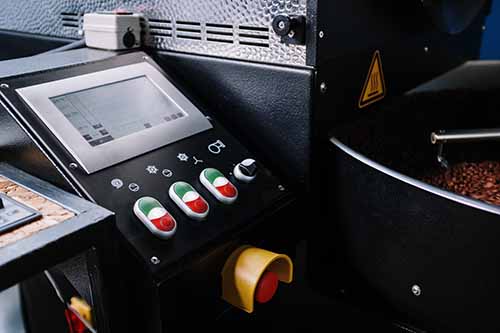
Why Invest in a Dedicated Coffee Grinder?
It’s important to understand the advantages of making a purchase of a specialised coffee grinder. Many of you will know about the significance of freshly

Roasting is the process of heating green coffee beans to create the characteristic flavour and aroma of coffee. There are several different roasting methods, each of which can affect the flavour of the coffee in different ways.
The different roasting methods are influenced by the temperature and duration of the roast. For example a light roast is roasted for a short amount of time, and at a (relatively) low temperature, where as a dark roast is the opposite – a longer amount of time and a high temperature.
Roasters use different techniques to create unique blends, such as blending beans from different regions or different varieties, or by using different roasting methods to bring out different flavour notes in the beans. Professional roasters use a combination of art and science to create unique blends. They carefully select the beans, taking into account the variety, region, and growing conditions. They will also experiment with different roasts to achieve the desired flavour profile. The coffee roasters rely on their senses, such as sight, smell, and taste, to monitor the roast and make adjustments as needed.
The roasting process is a crucial step in the production of coffee. The different roasting methods affect the flavour of coffee in different ways and professional roasters use a combination of techniques to create unique blends. The roasters select beans from different regions or varieties, use different roasting methods, and carefully monitor the roast to achieve the desired flavour profile. Roasting is a combination of art and science, and it takes skill and experience to create unique and delicious blends of coffee.

It’s important to understand the advantages of making a purchase of a specialised coffee grinder. Many of you will know about the significance of freshly

Roasting is the process of heating green coffee beans to create the characteristic flavour and aroma of coffee. There are several different roasting methods, each

Coffee is a beloved beverage enjoyed in many cultures around the world, each with their own unique way of consuming and appreciating it. Coffee in

The Chemex; people have been enjoying it for nearly 100 years, and it remains one of the best ways to enjoy a light, fruity roast.

There are many different brewing methods for coffee, each with its own unique flavor profile and set of pros and cons. Here are a few

The History of Coffee in Ethiopia The origins of coffee can be traced back to the ancient kingdoms of Ethiopia, where legend has it that
Contact Us:
8 Benhar Close,
Kelson,
Wellington,
NZ.
Call:
022 108 3212
Email:
Contact@beanmerchant-dev.10web.me
Copyright ©️ 2024 Bean Merchant. All Rights Reserved.
We do not hold financial information, all secure data is encrypted via Stripe.
Try our unique coffee flavour profiling quiz to find your perfect coffee beans.
Bean Merchant is New Zealand’s most relied upon curator for home coffee delivery. Whatever coffee flavours you are after, we have the widest variety to choose from.